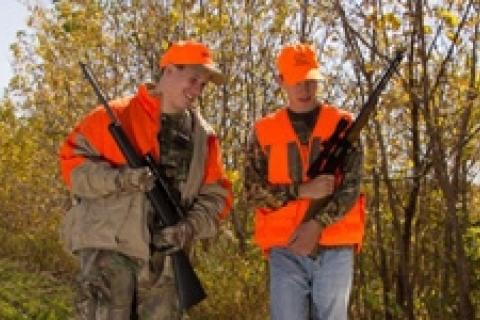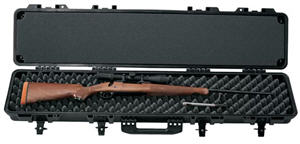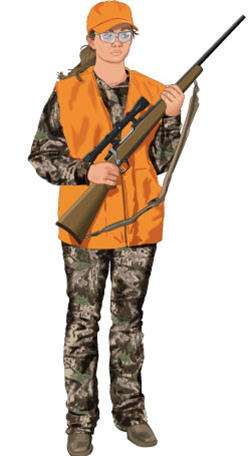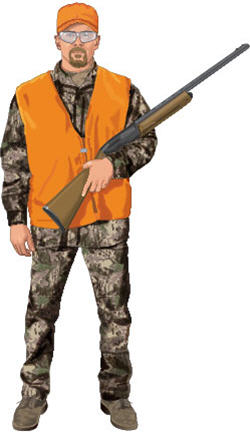
Keep you finger off the trigger, muzzle pointed at the ground, safety on until ready to shoot and know what is beyond your target. These safety practices are drilled in our minds from the very beginning for a reason — they contribute to safe hunting! While these general safety rules might seem simple, the occasional reminder converts to safer hunting for all.
 What exactly is taught in today's hunter education courses? Well, a lot of the same proven methods that have been taught in the past. For example, let's take a look at the first step to any hunt: transporting firearms. Believe it or not, year after year people are injured in or around their vehicles. When you're heading to your favorite spot, don't forget to:
What exactly is taught in today's hunter education courses? Well, a lot of the same proven methods that have been taught in the past. For example, let's take a look at the first step to any hunt: transporting firearms. Believe it or not, year after year people are injured in or around their vehicles. When you're heading to your favorite spot, don't forget to:
- Completely unload your firearm — triple check that it is unloaded;
- Separate the firearm from ammunition;
- Place your firearm in a protective gun case;
- Secure the case so it doesn't move around your vehicle during travel;
- Never pull a firearm out of the vehicle towards you muzzle first; and
- Check the bore for obstructions once removed from the case.

In addition to transporting your firearm, proper handling in the field is an important piece to the safety puzzle. Especially when group hunting and, safe field carries minimize incident rates. Muzzle control is the big thing here — having full control of where the gun is pointed at all times. Here are a few proven methods for carrying your firearm in the field:

courtesy of Hunter-ed.com
Two-handed carry — The two-hand, also known as the ready carry, is when the firearm is gripped in both hands with the muzzle pointed up. Since the firearm is in both hands, this is one of the safest carries, allowing you to control the muzzle and bring the gun to shooting position quickly. Generally, this carry is desired most among safety instructors.
Shoulder carry — The shoulder carry is less safe than the two-handed carry, and isn't as good for getting into shooting position quickly. However, it keeps the muzzle pointed behind you, which is fine as long as nobody is hunting behind you. Many hunters resort to this carry as the day goes on and arms become tired. As with any carry, always consider muzzle direction with the shoulder carry.

courtesy of Hunter-ed.com
Trail carry — With the trail carry, the firearm is gripped in one hand allowing the other to be free. This carry should only be used when hunting alone or when others aren't in front of or to the side of you.
Cradle carry — Similar to the two-handed carry, the firearm has two points of contact. One hand secures the firearm at the grip while the fore-end of the firearm rests in the bend of your elbow. This is a very comfortable way to hold a firearm, and like the shoulder carry is one that many hunters use when fatigue kicks in on a long hunt.
Sling carry — If your firearm or rifle has a sling, the sling carry can be quite useful. When the sling is over your shoulder, place one hand on the sling to add another point of contact. This is a secure carry, but isn't the fastest for going from the carry position to the shooting position. It takes practice to master transitioning the firearm from the sling carry to shooting, but it can be done.
These carries will give you control of the firearm from the carry position to shooting position. It's during the transition where many accidents happen. Plus, good control of the firearm leads to faster target acquisition, making you a more effective hunter.
The Safe Zones of Fire
 In raising the gun from carry position to shooting position, you enter a whole new field of safety: safe zones of fire. This is incredibly important when hunting with a group. According to an online hunter education course on hunter-ed.com, the safe zone of fire for each hunter is a 45-degree field directly in front of the hunter. The reason for this is our peripheral vision limits what we can see clearly, and if you can't completely see that an area is clear and safe, then it's outside of your safe shooting zone.
In raising the gun from carry position to shooting position, you enter a whole new field of safety: safe zones of fire. This is incredibly important when hunting with a group. According to an online hunter education course on hunter-ed.com, the safe zone of fire for each hunter is a 45-degree field directly in front of the hunter. The reason for this is our peripheral vision limits what we can see clearly, and if you can't completely see that an area is clear and safe, then it's outside of your safe shooting zone.
Plus, when the action begins and target fixation kicks in, if you travel outside of your safe shooting zone you run the risk of overlooking buildings, roads, non-game animals or even other hunters clearly. Don't let target fixation override your sense of safety, and stick to your safe zone of fire.
In addition to transporting firearms, safe carries and zones of fire, crossing obstacles is another problem area. Say you and a hunting partner are stalking a deer and come across an old barbed-wire fence. What do you do? Even though you're in a hurry to get in position for the shot, it's essential to cross the obstacle safely. This calls for:
- Unloading the firearms;
- Exchanging unloaded firearms;
- One hunter crossing the fence;
- Once across, exchanging both firearms after he/she crosses the fence; and
- Second hunter crossing the fence
It sounds like a lot, but these quick steps could prevent a major problem if you take a tumble or get hooked up in the fence. Same goes for crossing an obstacle alone, unload the firearm, place it on the other side, cross the obstacle and then grab your firearm.
For hunters, safe firearm handling is extra important when entering and exiting the hunting tree stand, especially during the climb. Recall the three-point rule of climbing into a stand. If both hands are required to climb into a tree, what's the best thing to do with your gun? Sling the gun on your back and start climbing? Wrong! It is much safer to purchase a gear hoist system to pull your gun up after your ascent. Even then, make sure that the firearm is unloaded, with the barrel pointed in a safe direction.
All in all, safety should be of utmost importance on each and every hunt. The truth is, you can only hunt if you are alive and well. So make an effort to enter the field with a safety conscious mind. Remind your fellow hunters to do the same. Lastly, these safety practices only scratch the surface for safe hunting habits, but are absolutely crucial and should never be forgotten or ignored.
- 24611 views

